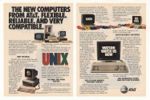Difference between revisions of "UNIX"
(move CSRG list, add cat, etc) |
(correct data) |
||
| Line 1: | Line 1: | ||
{{Infobox OS | {{Infobox OS | ||
| − | | name = | + | | name = UNIX |
| creator = Ken Thompson, Dennis Ritchie and Douglas McIlroy at Bell Labs | | creator = Ken Thompson, Dennis Ritchie and Douglas McIlroy at Bell Labs | ||
| year introduced = 1969 | | year introduced = 1969 | ||
| − | | architecture = Originally [[PDP-7]], then [[PDP-11]]; now cross-platform. | + | | architecture = Originally [[PDP-7]], then [[PDP-11 architecture|PDP-11]]; now cross-platform. |
| type = [[Time-sharing]] | | type = [[Time-sharing]] | ||
| − | | multitasking = | + | | multitasking = [[Multi-tasking]] with [[swapping]]/[[virtual memory|paging]] (latter added in a later version) |
}} | }} | ||
| − | '''Unix''' (officially trademarked as '''UNIX'''® - the documentation switched from using 'UNIX' to 'Unix' as of V7) is a computer [[operating system]] originally developed in the | + | '''Unix''' (officially trademarked as '''UNIX'''® - the documentation switched from using 'UNIX' to 'Unix' as of V7) is a computer [[operating system]] originally developed in the 1970s by a group of AT&T employees at Bell Labs including Ken Thompson, Dennis Ritchie and Douglas McIlroy. |
Today's Unix systems are split into various branches, developed over time by AT&T as well as various commercial vendors and non-profit organizations. A number of clones of Unix, which share the interfaces, and 'look and feel', but no code, have also been produced. | Today's Unix systems are split into various branches, developed over time by AT&T as well as various commercial vendors and non-profit organizations. A number of clones of Unix, which share the interfaces, and 'look and feel', but no code, have also been produced. | ||
Revision as of 10:47, 7 April 2019
| UNIX | |
| Type: | Time-sharing |
|---|---|
| Creator: | Ken Thompson, Dennis Ritchie and Douglas McIlroy at Bell Labs |
| Multitasking: | Multi-tasking with swapping/paging (latter added in a later version) |
| Architecture: | Originally PDP-7, then PDP-11; now cross-platform. |
| Date Released: | 1969 |
Unix (officially trademarked as UNIX® - the documentation switched from using 'UNIX' to 'Unix' as of V7) is a computer operating system originally developed in the 1970s by a group of AT&T employees at Bell Labs including Ken Thompson, Dennis Ritchie and Douglas McIlroy.
Today's Unix systems are split into various branches, developed over time by AT&T as well as various commercial vendors and non-profit organizations. A number of clones of Unix, which share the interfaces, and 'look and feel', but no code, have also been produced.
Versions of relevance for hobbyists include:
- Unix System 1 - The first version of UNIX that has been recently made to run on the PDP-11
- UNIX V5 - One of first version with known source and binaries available.
- UNIX V6 - The last version before branches started to appear
- Unix V7 - One of the most complete and the last generally available and PDP-11 version of Research UNIX
- Unix/32V - A 32bit port of System 7 to the VAX 11/780.
Unix then went commercial and was sold. Below is an early ad for AT&T UNIX.
CSRG releases
Meanwhile the CSRG kept on releasing newer BSD UNIX's derived from 32v. Descended from there are several popular versions:
- FreeBSD focuses on providing a system geared towards a single user.
- OpenBSD derived from the NetBSD project will run on all kinds of systems.
See also
| v • d • e UNIX Versions, Vendors and Related |
|---|
| Research Unix PDP-7 UNIX • V1 • V2 • V3 • V4 • V5 • V6 • V7 • V8 • V9 • V10 • LSX • MINI-UNIX • Unix/32V
AT&T - CB-UNIX • PWB/UNIX • USG UNIX • System III • System IV • System V BSD - 2.9 BSD • 2.10 BSD • 2.11 BSD • 3BSD • 4BSD • 4.1 BSD • 4.2 BSD • 4.3 BSD • 4.4 BSD BSD Descendants 386BSD • NetBSD • FreeBSD • OpenBSD • NeXTSTEP • Darwin |
| Other - xv6 • AMIX • SunOS • Solaris • ULTRIX • A/UX • XENIX • AIX • Dell UNIX |
